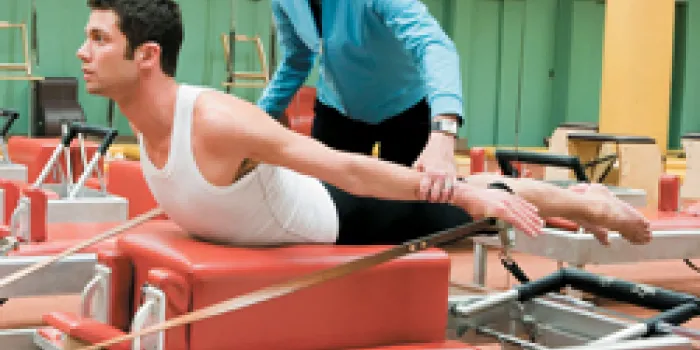Have you ever wondered what those old-fashioned-looking black tables with straps are used for at the gym? More than likely they are “Reformer” tables, which date back to the 1920s and are used in Pilates, a series of exercises designed to build strength in the core of one’s body that includes the abdominal region, back and shoulder blade stabilizers.
Pilates, which also involves mat exercises, has become popular in the past few years, with classes being taught in gyms and by private trainers nationwide. Pilates, however, is not a fad. It has been a favorite with professional dancers for more than 80 years. Similar to yoga, Pilates focuses on muscle control, breathing, proper alignment and balance. People who do Pilates exercises enjoy multiple benefits, including increased energy and strength, a more toned body and greater flexibility.
For those with bleeding disorders, the benefits of Pilates and other similar exercises are that they help the body become stronger and, ideally, can decrease susceptibility to bleeding episodes in the muscles and joints. Because of these potential benefits, healthcare providers are starting to explore Pilates and how it can be safely adapted for those with bleeding disorders.
Most Pilates exercises are safe, but some need to be modified for people with bleeding disorders. According to “Playing It Safe,” a sports and exercise booklet published by the National Hemophilia Foundation, Pilates is rated 1.5 on a scale from 1 (safe) to 3 (dangerous). It is in the safe to moderate risk category along with bicycling and spinning. But keep in mind, as with any new activity, it is important to discuss Pilates with your comprehensive healthcare team.
Pilates Basics
Pilates is named for Joseph Pilates, its German-born inventor. While interned in England as a prisoner of war during World War I, he developed exercises for other detainees that could be done on a mat or bed. He opened a studio in New York City in the 1920s, teaching dancers how to build their core strength. Today, a number of Pilates methods are taught, including the popular Winsor and Stott Pilates.
The basic foundation of Pilates is focused movements that concentrate on strengthening the core part of the body, which includes the “powerhouse”—the abdomen, lower back and buttocks. The hips and shoulders are also important areas of focus. Building a strong core enables people to do activities that involve the extremities without putting as much stress on the joints, explains Sherry Herman-Hilker, PT, a physical therapist in the University of Michigan Hemophilia and Coagulation Disorders Program at the C.S. Mott Children’s Hospital in Ann Arbor, Michigan. “If core muscles are strong, you are stabilizing your pelvis and spine so that when you are doing things with the arms and legs you are operating from a strong base,” she notes.
Like other Eastern-based exercises, Pilates strongly emphasizes correct breathing. Proper form is also crucial, such as having what is known as a “neutral spine,” along with correct pelvic, rib, scapular (shoulder blade) and head placement. Pilates can be done on a mat or on an apparatus such as the Reformer, where one lies down and uses attached springs and straps to perform resistance exercises. Workouts may also incorporate balls, foam rollers and resistance bands. But experts say that first-timers should begin with mat exercises before transitioning to the more complex equipment.
Shoes are not generally worn in Pilates, and it is best to wear loose-fitting clothing for unrestricted movement. One can benefit from taking Pilates once a week, but three one-hour sessions a week are ideal.
Getting Started
Although Pilates exercises are low-impact, injury is possible. This is because Pilates is multifaceted, involving correct movement and breathing simultaneously. “The exercises are more about the mind-body connection and the concentration on form,” says Patty Connors, PT, OMPT, a physical therapist at the University of Michigan Spine Program in Ann Arbor, who is also a certified instructor of Stott Pilates. When form is off, injuries can occur. For example, she says, “If you are doing a back exercise with your legs in the air and your spine is pivoting and your legs are out of control, you can injure yourself.”
Most Pilates exercises can be modified to place less pressure or strain on specific joints and muscles. For example, since the most vulnerable area to bleeding is the hip flexor, it is best to avoid aggressive stretching of the front of the hip, says Connors. She adds that it’s best to avoid overstretching. Individuals with bleeding disorders should also be careful of some of the weight-bearing exercises involving the wrist. Consider working with a trainer to use an assistive device to keep the wrist in a neutral position.
Connors advises working one on one with a well-qualified trainer when starting out. This person ideally should be a physical or occupational therapist who is also Pilates-certified. “Your instructor will help you know when you are doing the exercises incorrectly and increasing your risk of injury,” says Connors.
Herman-Hilker agrees, adding that it is also important to tell the instructor about your bleeding disorder in advance. “You will have to say, ‘I have mild hemophilia, which means I only bleed if I have surgery or trauma.’”
The trainer should also be aware of your range of motion, any restrictions you may have and the joints in which you’ve had bleeds.
Finally, individuals should know what their healthcare provider recommends, adds Herman-Hilker. “They shouldn’t count on the Pilates instructor to be able to independently make those decisions.”
While there are several variables to consider before deciding whether Pilates is right for you, the benefits are still many. For only three hours a week, Pilates allows you to focus your energy while providing a low-impact, full-body workout with long-term results, such as improved flexibility, stamina and strength.

